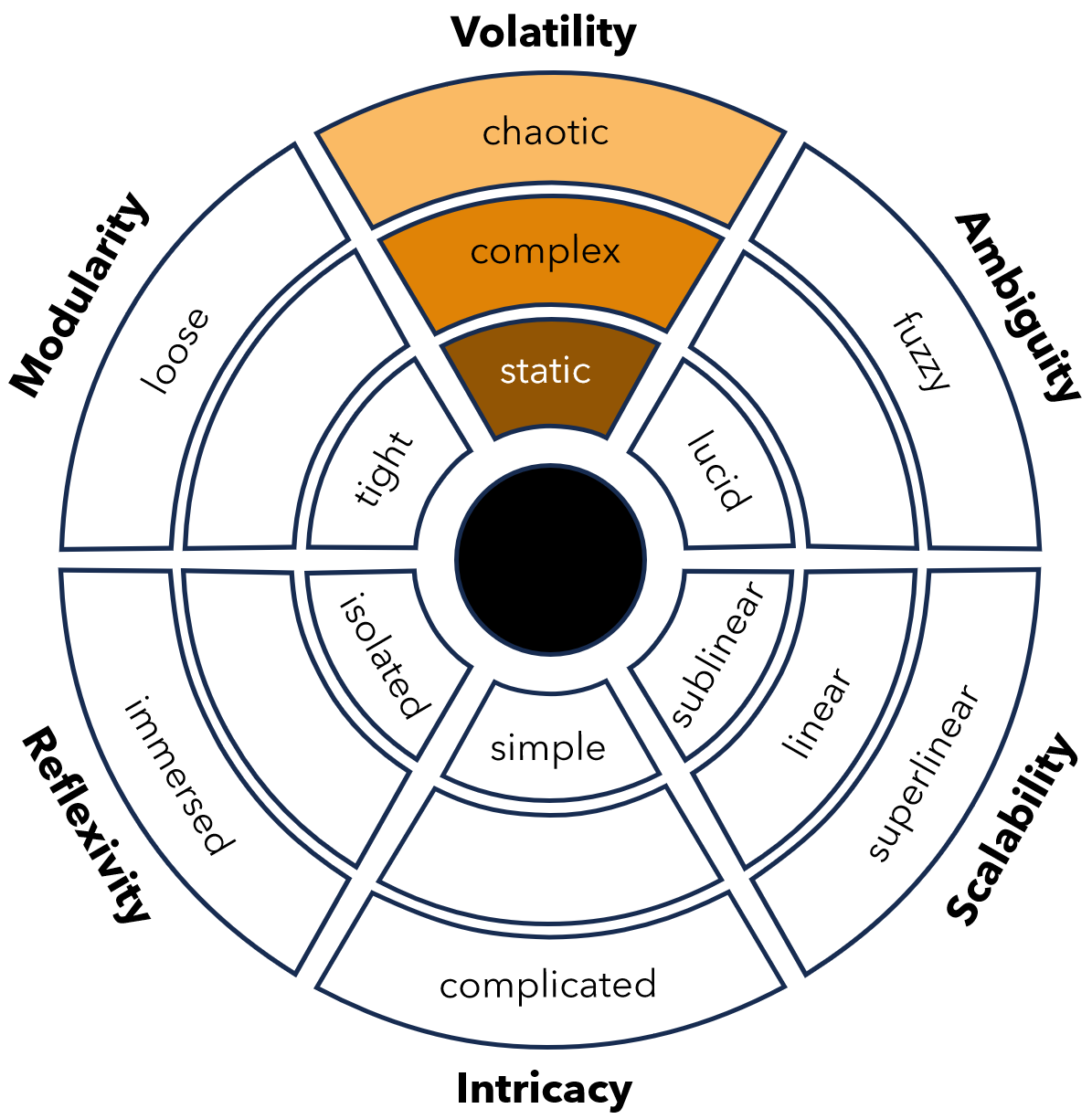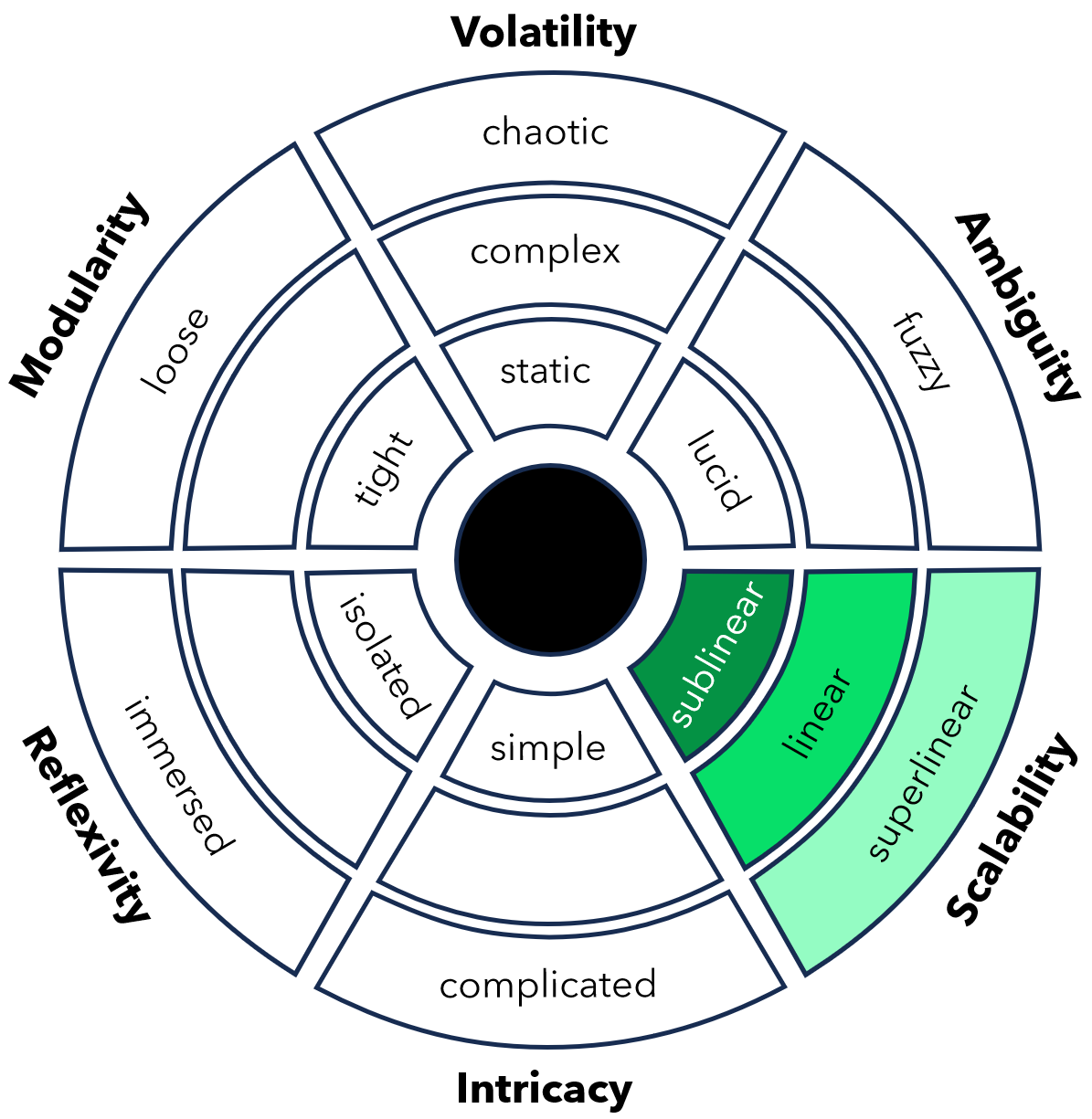A Wicked Framework for Wicked Problems
A wicked problem is a complex issue that is difficult to define and has no clear solution. It often involves conflicting stakeholders, incomplete information, and interconnected challenges. Wicked problems emerge in systems loaded with uncertainty. We can begin taming wicked problems when we understand at least six kinds of uncertainty.
When we think about systems, we tend to categorize them into a few system types, such as simple, complex, and complicated. But such a classification can often oversimplify reality. To better understand the complexity of wicked problems, we can evaluate them across six dimensions: Volatility, Intricacy, Modularity, Scalability, Ambiguity, and Reflexivity. Each aspect helps reveal how systems operate and interact, allowing for a more nuanced perspective than a reductionist approach of just a few system types.
Volatility: From Static to Chaotic
The first kind of uncertainty is Volatility, the degree to which a system’s behavior or outcomes fluctuate over time. Such behavior can range from static—predictable and stable—to chaotic—with highly unpredictable outcomes. The FIFA World Cup provides a good example. On one hand, the structure of the event is static: it takes place every four years, with fixed rules and teams, and we know the format will remain pretty much constant. However, the outcomes, such as which teams will win or advance in the rankings, can appear chaotic, driven by a combination of skill, luck, and unexpected events—similar to stock market dynamics. This shows that even within a seemingly ordered system, chaos can be observed depending on how we define the system.
In business, when systems are more volatile, we need to adopt flexible plans to adjust for the unpredictability of outcomes. Static systems, on the other hand, allow for traditional, linear planning. Understanding where a system falls on this volatility spectrum helps organizations choose the right strategies for managing this uncertainty.
Intricacy: From Simple to Complicated
The second kind of uncertainty in systems and wicked problems is their Intricacy or the complicatedness of their internal structure. Systems can be simple, with few components that interact in straightforward ways, or complicated, involving numerous interconnected elements. For instance, consider something as commonplace as a “smart” electric car key. From the driver’s perspective, the key may seem simple—just a few buttons and obvious icons. However, a mechanic or engineer would likely view it as a complicated system, given the intricate circuits and technology on the inside that make the car key do its job.
This relativity of the observer highlights that a system’s intricacy or complicatedness often depends on the observer’s focal point or level of expertise. For managers, recognizing when a system is simple or complicated informs the decision-making process: fixing simple problems requires little more than common sense while addressing complicated systems might require expert analysis.
Modularity: From Tightly Integrated to Loosely Coupled
The third kind of uncertainty is Modularity: this refers to how easily a system’s components can be separated or interchanged without disrupting the whole. Some systems are tightly integrated, allowing for little or no reconfiguration, like a network of railroads. In contrast, air traffic systems are more loosely coupled, allowing for greater adaptability. Airlines can adjust schedules, routes, and capacities to match demand, while a railway timetable is more rigid and limited to a tightly integrated railroad pattern.
Increased modularity makes systems more adaptable but also introduces uncertainty as the number of potential configurations increases. For example, while railways themselves are tightly integrated, individual trains are nevertheless entirely modular—train cars can be easily reconfigured. On the other hand, airplanes are much less modular; you can’t just modify the parts of an aircraft the way you can rearrange train cars. The balance between integration and modularity in a system influences how it reacts to change and how resilient or flexible it can be in the face of disruption.
Scalability: From Sublinear to Superlinear Growth
The fourth kind of uncertainty is Scalability: the ability of a system to grow or handle increased workloads without losing efficiency. Systems can scale in different ways—sublinear, linear, or superlinear. Sublinear scaling, where growth slows relative to input, is observed in large species or infrastructure like skyscrapers. Superlinear growth, on the other hand, occurs when systems, such as swarms, cities, or social networks, expand faster than the increase in their inputs.
In organizational terms, deciding whether to scale up (centralizing growth into a larger single entity) or scale out (expanding into multiple smaller entities) can significantly impact efficiency and adaptability. For example, a company that grows into a massive organization may face bureaucratic inefficiencies (sublinear growth), while one that spreads into smaller, autonomous units might enjoy more flexibility and faster innovation (superlinear growth). Understanding how a system scales helps leaders decide the best path for sustainable growth.
Ambiguity: From Lucid to Fuzzy
The fifth kind of uncertainty is Ambiguity. Ambiguity in systems comes from unclear boundaries, relationships, or outcomes. In some systems, boundaries and roles are clearly defined, leading to predictability—what we might call lucid systems. Boundaries can be much more blurred in other systems, such as human communities or organizations. For example, defining who belongs to the LGBTQ+ community can be tricky, as the lines between who is “in” and who is “out” are often subjective and contested. Whether someone is an enemy or an ally can be a matter of intensive debate.
In organizational contexts, ambiguity often arises around team dynamics. Team members might disagree on what constitutes “the team,” leading to different interpretations of roles and responsibilities. When systems are ambiguous, management must focus on probing and experimenting to gain clearer insights rather than relying on straightforward decision-making.
Reflexivity: From Isolated to Immersed
The sixth kind of uncertainty is Reflexivity. Reflexivity refers to how much a system’s behavior is influenced by the behavior of its observers and participants. In isolated systems, external perceptions and interactions have little impact. For example, a dog on a leash may behave in a relatively predictable way, regardless of how its human caretakers talk about the dog. On the other hand, human systems are deeply reflexive. A group of children labeled as “troublemakers” might begin to behave in exactly that way, fulfilling the expectations placed on them. This feedback loop between perception and behavior creates increased complexity in human systems.
A system’s reflexivity complicates efforts to observe or manage it objectively. For example, employees’ awareness of how they are being evaluated can influence their behavior, creating a cycle that might reinforce or challenge the initial assumptions. Recognizing the reflexive nature of a system helps managers understand the limitations of traditional observation and control methods .
Taming Wicked Problems
We now have six dimensions or qualifications of systems: Volatility, Intricacy, Modularity, Scalability, Ambiguity, and Reflexivity. Are these the only ones? Certainly not. Some readers of this article will be able to produce a few more. But this is a workable set. The benefit of this model, and why I prefer it over more reductionist, simplistic ones, is that it allows us to assess and discuss a much wider variety of systems. Recognizing only four or five system types doesn’t do justice to the incredible variety of systems in the universe. With the model described here, we get a hundred or more patterns of wicked problems and systemic behaviors, and each could be worth discussing.
In understanding these six dimensions—volatility, intricacy, modularity, scalability, ambiguity, and reflexivity—we can better navigate the complexity of our systems. No single model can fully capture the range of behaviors systems exhibit—and the Wicked Framework is still a simplification of reality—but evaluating systems along these six axes allows for more tailored and adaptive strategies. Instead of applying a one-size-fits-all solution, this framework might help us recognize the unique characteristics of the systems we manage and choose appropriate methods to handle at least six different kinds of uncertainty.







